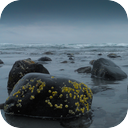(short preview of full seamless looping track)
(short preview of full seamless looping track)
(short preview of full seamless looping track)
(short preview of full seamless looping track)
(short preview of full seamless looping track)
Rocky Beach
This product is not available in the selected currency.
In Stock
Backordered
Out of Stock
Description
The shallow shore sparkles with rocks resting, scattered along the sandy avenue, sunning themselves for the last thousand years in the same spot and under the same sun, never needing to know what lay in front or what has fallen away behind them. You watch as the impression of your foot quickly fills with water and smoothes again, no trace you had ever landed upon this shore, and no rock interested enough in your story to retell it. A beach is an unstable environment which exposes plants and animals to changeable and potentially harsh conditions. Some small animals burrow into the sand and feed on material deposited by the waves. Crabs, insects and shorebirds feed on these beach dwellers. The endangered Piping Plover and some tern species rely on beaches for nesting. Sea turtles also lay their eggs on ocean beaches. Seagrasses and other beach plants grow on undisturbed areas of the beach and dunes. Ocean beaches are habitats with organisms adapted to salt spray, tidal overwash, and shifting sands. Some of these organisms are found only on beaches. Examples of these beach organisms in the southeast US include plants like sea oats, sea rocket, beach elder, beach morning glory, and beach peanut, and animals such as mole crabs, coquina clams, ghost crabs, and white beach tiger beetles. Due to intense use by the expanding human population, beaches are often dumping grounds for waste and litter, necessitating the use of beach cleaners and other cleanup projects. More significantly, many beaches are a discharge zone for untreated sewage in most underdeveloped countries; even in developed countries beach closure is an occasional circumstance due to sanitary sewer overflow. In these cases of marine discharge, waterborne disease from fecal pathogens and contamination of certain marine species is a frequent outcome.
Opps
Sorry, it looks like some products are not available in selected quantity.



